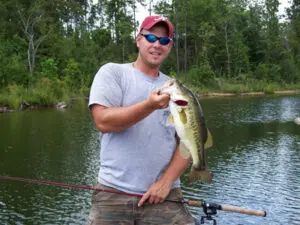PLEASE SHARE
WE ARE YOUR SOURCE FOR FISHING DESTINATIONS IN ALABAMA!
Big Creek's Late Summer Pattern for Largemouth Bass

Target 5-pounders on Big Creek Lake this year using Hawey’s proven late summer patterns.
By Eileen Davis
Located 12 miles west of Mobile, Big Creek Lake covers 3,600 acres and provides water to the city. Big Creek’s system is local and originates in adjacent Washington County. In addition to two main feeder creeks, six springs supply clear water to the reservoir.
For this part of the state, the lake is extremely deep — 55 to 60 feet deep at the dam – and submerged creek channels reach depths of more than 20 feet. But winning patterns here in September don’t focus on structure; instead weed beds hold the key to success.
Tournament anglers on Big Creek Lake know the man to beat is Kevin Hawsey of Georgetown. Unquestionably a master of fishing aquatic vegetation in clear water, Hawsey’s biggest largemouths weighed 9 ¼ and 9 ½ pounds, and he frequently lands four pounders. An average fish from the lake’s infertile water measures 10 to 14 inches.
Hawsey caught these fish on a lake with a reputation as being the most difficult water to fish in this part of the state. His favorite patterns for late summer take place on main lake weedbeds, and its depth hinges on the amount of light reaching the fish. Under the low light of early morning, Hawsey fishes weeds next to the bank. When the shallow water action dies, he moves away from shore to target weeds on main lake points.
“The early morning bite is critical for winning tournaments,” Hawsey emphasized. “This is when you’ll catch largemouth weighing up to 5 pounds.”
Catching shallow water bass is not difficult. However, a systematic approach aids in finding big fish, especially when time is limited. Hawsey says the most important factor is having deepwater nearby.
“A quick look at a map shows where creeks flow into the lake,” he advised. “Target shallow water on the main lake at the mouth of a pocket next to a creek. Fish move out of the deep water to feed on bream and shad next to the bank.”
Within his selected fishing area, Hawsey next looks for feeding activity on the surface. He says bass use the grass and bank to ambush and corral their forage in the shallow water.
“Anglers make the mistake of fishing the outside edge of the grass,” Hawsey continued. “Work the lure as far back in the grass as possible. That’s where you get the big bites. You wouldn’t think of catching them in grass so thick.”
To cast a lure the required distance, Hawsey uses a 7-foot rod spooled with 15-pound-test monofilament. He says the best lures for this pattern are either a fluke or trick worm rigged weightless on a 5/0 hook.
By 9 o’clock, later if the wind is blowing or skies are overcast, the bass and Hawsey abandon the shallows for deeper water. With their morning hungry satisfied, the bass probably move back to the creek channel. Hawsey, on the other hand, switches to main-lake points. He’s hoping to find actively feeding bass in weeds 6 to 10 feet deep.
“These are long tapering points with the entire point covered in grass,” Hawsey noted. “Bass either cruise in and out of the weeds looking for baitfish, or they sink into the weeds to ambush their prey.”
Hawsey’s go-to lure for fishing points is a Zoom lizard in watermelon red. For cruising fish, he rigs it Carolina style so the lure floats higher in the water. If the fish are buried in the weeds, he rigs it Texas style.
Located at the end of Howell’s Ferry Road, Fox Landing is the only boat ramp on the reservoir. The launch fee is $5 at the ramp.
Read more about how successful anglers find and catch Bama’s fish.
